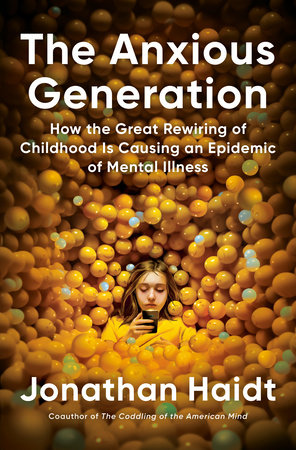In Jonathan Haidt’s profound new book, The Anxious Generation: How the Great Rewiring of Childhood is Causing an Epidemic of Mental Illness, he has reason to cite Oliva Rodrigo’s song “Jealousy, Jealousy,” a song about the travails of the social media world. Haidt writes, “It’s a powerful song; I hope you listen to it.” Being an obedient soul and having my iPhone handy, I opened Spotify and gave the song a listen. Since I was on my phone anyway, I decided I should check my email. And heck, while I was at it, why not see if there is anything new on X? Oh, and the NCAA basketball tournament was ongoing. I should check in on scores to see if there is any close game or upset brewing. The next thing you know I’d been on my phone for about twenty minutes, all to listen to a song that is less than three minutes long. As I am at least a little self-aware, and I was reading a book on how technology influences the brain, I realized that I had just fallen prey to the smartphone trap and returned to the book.
While many of us have had this experience, people like me (i.e., old) are not the subject of Haidt’s book. He is most interested in explaining how the ubiquity of mobile technology coupled with safety-first parenting techniques have changed how young people experience the world. Generation Z is indeed anxious. The statistics are by now well-known: increases in depression, anxiety, loneliness, and self-harm, including suicide. The pathologies are particularly prevalent in young girls. Why has this happened? Haidt suggests that this anxiety stems from a lack of resilience, as young people are shielded from adversity and discomfort, hindering their ability to cope with life’s challenges. Haidt declares, “My central claim in this book is that these two trends—overprotection in the real world and underprotection in the virtual world—are the major reasons why children born after 1995 became the anxious generation” (emphasis in the original).
Haidt’s book is a tour de force. I can give it no higher praise than to say I wish we could put this book in the hands of every parent, teacher, school administrator, schoolboard member, and legislator in the country. Haidt convincingly shows that mobile technology—mostly but not exclusively smartphones—does not just correlate with all these dire mental health trends but indeed contributes to causation.
The first smartphone, the iPhone, was released in 2007. Samsung produced its model shortly thereafter. In less than ten years, by about 2015, nearly 80% of American households had a smartphone. Haidt puts great stock in the fact that the first iPhone with a front-facing camera came out in 2010, making that date a kind of inflection point in kids’ online experience. Not coincidently, Instagram membership exploded. Purchased by Facebook in 2012, Instagram’s membership soared from 10 million in 2011 to 90 million just two years later. Haidt reports that 40% of American children under the age of 13 have an Instagram account, notable as the legal age to sign a social media contract is 13. “By 2015, more than 70% of American teens carried a touch screen around with them.” Most children’s lives are dominated by what Haidt calls “phone-based” technology. While he primarily means smartphones, he also includes “laptop computers, tablets, [and] internet-connected video game consoles.”
Why does the omnipresence of such portable technology matter, especially for mental health? We must make a distinction between the “real world” and “virtual world.” The real world, says Haidt, is embodied, consisting of experiences that are synchronous (happening right now) and having some level of intimacy. They also “take place within communities that have a high bar for entry and exit,” giving people incentive to invest in the relationship, and forgiving and repairing relationships when they hit rough spots.
By contrast, the virtual world is disembodied. If fact, some participants might be AI. It is asynchronous, as communication is typically through posts and comments. Also, communication is “one-to-many,” meaning it is directed towards a mass of people with whom we lack any actual personal relationship. Finally, virtual communities are unstable in that relationships are easily entered into and easily broken.
The lack of intimate embodied human relationships contributes toward poor mental health. The nature of the online world tends to draw young people within themselves, neglecting real world experiences they need to develop into emotionally healthy, responsible individuals, while simultaneously addicting them to the very virtual world that contributes to their anxiety and depression.
Readers of such authors as Nicholas Carr, Sherry Turkle, and Matthew Crawford will be familiar with Haidt’s discussion of the manner in which technology ropes people in. Using many of the same techniques the gambling industry uses to maximize a gambler’s stay in a casino (“playing to extinction” as the gambling industry puts it), social media designers developed features such as “likes” and scrolling to dole out small dopamine hits as the brain consistently takes pleasure in finding something new or affirmation of one’s own posts. Designers have mastered the precise number and timing of dopamine hits to maximize how long we spend on websites, apps, etc. Think of the small awards apps or games hand out such as congratulations for “leveling up,” or “coins” to buy new accessories for your character in an online game, or acknowledging you for daily streaks of playing a game or visiting a site. The brain then begins to crave those dopamine hits. That explains why, after listening to the Olivia Rodrigo song, I then sought out a couple quick hits of dopamine in the anticipation of a new email or a fun post on X. This is bad enough for older adults such as me. It is deadly to young people whose brains (to say nothing of souls) are being formed. Haidt argues that kids between the ages of 9 and 15 are particularly susceptible to the harmful effects of social media.
Time spent staring at screens harms young people by taking kids away from healthier uses of their time. Haidt draws upon the economic concept of opportunity costs. It isn’t just the direct harm caused by social media and other screen-based activities; it is what young people aren’t doing, such as being outside, interacting with friends face-to-face, engaging in unstructured play. Time on screen distracts from forming deep friendships. Teens may have many online “friends,” but these are low quality friendships that do not help forge healthy character or contribute to happiness.
In addition, screen use is linked to sleep deprivation. The urge to always be online often leads kids to stay up late at night, sneaking a device into the bedroom in ways previous generations might have snuck in a book or a portable television. In addition, the blue light from the screen tells the body that it is daytime, inhibiting the production of melatonin that informs the body it is time to sleep. Sleep deprivation is particularly harmful to teens, whose rapidly changing brains require more sleep.
For the reasons explained above, screentime also lowers attention span. The constant notifications as well as the design of apps and websites encourage that desire for a dopamine hit. The user then struggles not to think about being online and can never really focus on the task at hand. As Haidt notes, just the presence of a smartphone within arm’s reach is enough to distract the user or deter conversation. Algorithms and autoplay encourage addiction, adding to the anxiety felt by users.
All the above contributes significantly to young people’s anxiety and unhappiness. Haidt also spends a great deal of the book discussing precisely what makes for happy children. The book operates in part as a parenting guide, a highly effective one at that. Borrowing from Lenore Skenazy’s “free-range kids” advocacy, Haidt leads the reader through the literature showing the short- and long-term benefits of “free play” and risk taking. By trying to keep our kids safe, we deprive them of the little failures, the bumps and bruises that are part of growing into a responsible, self-controlled adult. It seems odd, but the fact that kids are making fewer trips to the emergency room is not a sign of progress. Kids need to explore, take on manageable risks, to be free at times of adult supervision. Yes, they will sometimes get hurt, but they need to learn about what their bodies can and cannot do. As Haidt puts it, “It’s as if we gave our infants iPads loaded with movies about walking, but the movies were so engrossing that kids never put in the time or effort to practice walking.”
By isolating our kids from all harm, we have left them incapable of dealing with life’s inevitable bumps in the road. Haidt draws on Nassim Nicholas Taleb’s concept of anti-fragility. As our immune systems are made stronger by exposure to pathogens, we learn to deal with stress and failure by experiencing them in small amounts. Kids need to learn how to cope without mom and dad around. That means going to the store by themselves. That means playing games away from adult authority, forcing kids to make and enforce their own rules. Such activities are auditions for the more serious work of adult life. Having prioritized safety over all else (my local public high school proudly states that safety is its number one priority), we have actually harmed our young people.
Haidt naturally has proposals for addressing these problems. He has advice for schools, parents, and lawmakers. For example, parents could work within their neighborhood to promote play amongst their children. Parents should also minimize if not eliminate the taking of screens into the bedroom. Child screentime should be done in common spaces under the supervision of a parent. Lawmakers should raise the age at which young people can legally join social media sites and require better enforcement by the social media companies. Schools must go phone free. I would go just one step further. After reading Haidt’s book I am now convinced that any school that puts a device into the hands of students is committing educational malpractice. Whether it is phones, tablets, or laptops, they are almost certainly doing more harm than good.
In this outline of Haidt’s book I feel I have failed to articulate the depth of Haidt’s insight and the importance of what he presents to his readers. He establishes the mental, physical, educational, and spiritual harm promoted by young people’s use of portable technology. Haidt persuasively argues that phone-based technology presents a public health crisis for advanced nations. I use the term public health quite purposefully. Like infectious diseases, the harm done by phone-based technology and social media is not reserved for those who are directly affected. The rest of us must live amongst those whom technology has maldeveloped. Haidt observes that since the advent of the smartphone “Students talked to each other less between classes, at recess, and at lunch, because they began to spend much of that time checking their phones, often getting caught up in microdramas throughout the day. This meant that they made eye contact less frequently, laughed together less, and lost practice making conversation. Social media therefore harmed the social lives even of students who stayed away from it.”
Those of us who work with young people have seen these pathologies develop over time. In one way or another I have been teaching college-age students for nearly thirty years now. I have noticed that the once rambunctious chitchat before class starts has devolved into an uncomfortable silence as students now quietly gaze into their phones. Student groups have dwindled as young people have become more withdrawn, uninterested in socializing with their fellow students. From information gleaned from a regular classroom exercise I can tell you that the amount of time young people spend on their phones and the number of “notifications” they get each day is dizzying. I have witnessed the arrival of a generation of students who are functionally illiterate, unable to focus long enough to read even the simplest books. The top accommodation I make for students with some kind of diagnosed disability has gone from those dealing with dyslexia or ADHD to “flexible attendance due to anxiety.” As a teacher, parent, and citizen, I wander from sadness to anger to fear as I ponder what the future will hold for my students, my community, and my own children. As a parent I can say that one fights technology like one is fighting the devil. Satan is the great seducer and so is the online world of social media, gaming, and video.
Jonathan Haidt’s book is informative. I have seldom read a book that taught me so much about its subject matter. That fact is even more remarkable in that Haidt is writing on a subject about which I already knew a great deal. Haidt is also a fine writer (or he has a good editor!), so the book makes for a pleasurable read. Very helpfully each chapter ends with a “Summing Up” section which articulates the chapter’s main arguments in a series of bullet points.
Still, this book is more than informative. It is wise. One of Haidt’s virtues as a public intellectual is that he is very measured and moderate in his speech. Pivotal to Haidt’s approach to social psychology, as noted in his book The Righteous Mind, is the appreciation of alternative viewpoints and of competing goods. His mindset and rhetorical style therefore allow him to be bold and challenging without being dogmatic. I found The Righteous Mind to be a bit reductionist, putting too much stake in Darwinian/evolutionary explanations for morality. I was happy, then, to find that Haidt has a whole chapter in The Anxious Generation on the spiritual costs and potential solutions to the problem of technology-based anxiety. Yes, Haidt has an evolutionary explanation for religion and morality, but he acknowledges this and shows respect for those who put more credence in supernatural foundations for morality and happiness. The mere inclusion of a chapter on spirituality is illustrative of a thinker who is seeing his subject matter from many different angles. Such an approach makes the argument more comprehensive and, thus, more convincing.
As I mentioned above, I think this book contains such wisdom that it should be essential reading for parents and policy makers alike. As I observe parents at my own kids’ functions, I am disturbed at the prevalence of smartphones and the use of screens as babysitters and time wasters. I would like to say that my wife and I are blameless on this account, but I cannot. Jonathan Haidt has convinced me that we need to approach smartphones and social media the way we once approached smoking or wearing a seat belt. I am not yet sure as to whether we need legislation on the matter (although I do think schools need to set strict policies), but we need a public education effort equal to the public health threat. Just as we made smoking or not wearing a seatbelt socially undesirable, we must do the same with the latest threat to public health. We must give childhood back to our children.







3 comments
D. M. Garzonio
Thank you for writing this review. I’ll have to check it out. With two young boys of my own, my wife and I discuss this topic with some degree of frequency. In regards to a smartphone policy, I think I’ll tell them the same thing I explain when they frantically grab for the toilet plunger in the bathroom: “This is a tool. Not a toy.”
Rob G
In a mere decade and a half these damned things have gone from luxury to convenience to necessity. Fifteen years! We’ve all been suckered, big time. But of course that was the plan.
Brian
So much to say on this topic. As the parent with a kid in college, one in high school, and one in middle school, it’s really hard. Kids socialize on their phones, so if you tell your kid they can’t have one, you’re telling them they can’t talk to their friends. It’s unfortunate but true. Tell them to just talk on the phone, or even in person, and they look at you like you have two heads. We held out far longer than most parents do, but by late middle school it’s really hard, and there is undeniable convenience to being able to always communicate and coordinate.
Wanted to quickly address this: “Schools must go phone free.” Schools tried that a decade ago. Parents completely revolted. There’s a widespread completely irrational fear of school shootings, parents are convinced that they’ll need to be able to contact their kid in an instant to make sure they’re alive should something like that happen at school, even though the odds are absolutely vanishingly small.
Comments are closed.